|
- Catalog (in stock)
- Back-Catalog
- Mail Order
- Online Order
- Sounds
- Instruments
- Projects
- History Face
- ten years 87-97
- Review Face
- our friends
- Albis Face
- Albis - Photos
- Albis Work
- Links
- Home
- Contact
- Profil YouTube
- Overton Network
P & C December 1998
- Face Music / Albi
- last update 03-2016
|
1. Acherongo - Acholi people - 8:05
2. Wagwagwawala - Baganda people - 7:18
3. Akanyomonyomo - Baganda people - 3:54
4. Ajolina - Acholi people - 5:17
5. Eyegema okuzaala - Baganda people - 6;00
6. Silimunyaigomu - Lugabara people - 5:24
7. Aferimoyambo - Alur people - 4:05
8. Maria mangada - Baganda people - 3:13
9. Kooma okuswankula - Baganda people - 5:49
10. Ajooga - Acholi people - 6:51
11. Mukyala kyusamu - Baganda people - 6:44
12. Abakono - Acholi people - 5:19
Traditional music from Uganda
Africa is inhabited by different ethnic groups, each with a musical tradition of its own. This is a rich traditional music heritage that has been orally transmitted from generation to generation for centuries. Despite external influences, the majority of these ethnic groups continue to value and practise their respective traditional musical styles, which in turn have to establish strong musical and cultural identities and continue to do so.
Ugandan music is generally rhythmic and the complexity of these rhythms varies due to the difference between the ethnic groups. These differences are also reflected in the varied instrumentation. Some musical genres are played on simple instruments while others, especially the dance music, are played in ensembles of complex instrumental formation. African music is usually pentatonic, but a few tribes also use a hexatonic scale. Most of the Ugandan vocal music is accompanied by traditional instruments. The literature embedded in vocal music is purposely meant to transform the social communities, i.e. in their structural adjustment.
Although Uganda is inhabited by a large variety of ethnic groups, a broad linguistic division is usually made between the Bantu-speaking majority and the non-Bantu speakers, who occupy the eastern, northern and north-western part of the country (these may be sub-divided into Nilotic and Central Sudanic peoples). By far the largest in number the Bantus have come from Central Africa from the Cameroon Highlands or Congo Basins. The non-Bantu peoples (they constitute less than one-tenth per cent of the population) the Acholi, Alur (Nilotic language groups who comes from the north), the Nilo-Hamitics and the Lugbara (Central Sudanic group) in the north.
The country
The republic of Uganda is an independent nation located in East Africa astride the equator, bordered on the east by Kenya, on the south by Tanzania and Rwanda, on the west by the Democratic Republic of the Congo (ex. Zaire), and on the north by Sudan. It covers an area of 241,040 sq. km. The population is approximately 28 million, of which 66 per cent are Christians, (the Anglican, the Catholics as well as the Pentecostal Church), 18 per cent practise traditional beliefs, and 16 per cent are Muslim. There were sizeable numbers of Sikhs and Hindus in the country.The official language is English, and the capital is Kampala.
The country has many lakes and swamps. The Lake Victoria and Lake Kioga flow into the river Nile. The Lake Edward and Lake Albert are situated on the border to Congo. A large part of Uganda is flat, there are volcanic mountains. The biggest is the Rwenzori mountain range at the border to the Congo with the highest point being the Margherita Peak on Mount Stanley 5'110 m. The Mount Elgon range at the border to Kenya with 4'321 m. The southwestern part of Uganda, is also mountainous. The rest of the country constitutes of grassland and forests. In the northeast, there is the semi-desert.
There is to be found a large variety of wildlife in the Kabalega National Park in the northwest and the Lake Mburo National Park in the south. The economy, in general, is agricultural, with matooke, cassava, sweet potatoes, plantains, millet and sorghum.
Uganda's long string of tragedies since independence has been a staple of the Western media, so most people still regard the country as a volatile place to be avoided. However, most parts of the country have been stable for several years, and the country's transformation has been little short of astounding. Kampala is now the modern, bustling capital of a new Uganda.
Ugandan Cultures
Uganda‘s population is made up of a complex and diverse range of tribes. Lake Kyoga forms the northern boundary for the Bantu-speaking peoples, who dominate much of east, central and southern Uganda. They include the Baganda people and several other tribes. In the north live the Langi and the Acholi, who speak Nilotic languages. To the northeast there are the Iteso and Karimojong, who are related to the Masaai and who also speak Nilotic languages. Pygmies (Batwa and Bambuti) live in the forests of the southwest.
Death is sometimes interpreted in the idiom of witchcraft; a disease or any other cause of death may not be seen as the true cause. At a funeral, if the relatives suspect someone of having caused the deceased person‘s death, a spiritual medium will call upon the spirit of the deceased and ask who had really killed him or her. In general, it is a fact that the women were the traditional healers. Magic powers and herbs were used for curing an illness or a disease.
Native art was very popular; Africans have adopted from the immigrants only as much as seemed to be in accordance with their way of life. Many defended their tribal traditions against Islamic influences, later on also against the Christian religion. The figured-plastic art Black Africa has become renowned for has not achieved the same level of importance among all peoples. Some tribes regarded the decorative painting of their huts or pottery as being more important, others held the carving of masks in great esteem. Among the Bantu people, sculpture was highly developed, its destribution quite clearly demonstrating that women assumed social supremacy.
Handicraft
Manual and artisan skills have been handed from one generation to the next one. Over time, their form, design, decoration (ornaments) and expressiveness have created an identity of its own within such communities (communes). Basketry, pottery and basic daily commodities for the household or for the daily work on the fields were also produced in common; the same was true for tools for the hunt and the prestige. Typical design forms and ornaments have become characteristic for such a community (tribe). For this reason, it is now possible to allocate the production of certain articles in their chronological and local framework to a certain community.
History
Indigenous kingdoms were etablished in Uganda in the 14th century. Among them, there were the Buganda, Bunyoro, Batoro (Toro), Ankole (Nkole) and the state Busoga. Over the following centuries, the Baganda people created the dominant kingdom. The tribes had plenty of time to work out their hierarchies, as there was very little penetration of Uganda from the outside until the 19th century. Despite the fertility of the land and its capacity to grow surplus crops, there were virtually no trading links with the East African coast. Contacts were finally made with Arab traders and European explorers in the mid-19th century - the latter came in search of ivory and slaves.
- More information you will find in
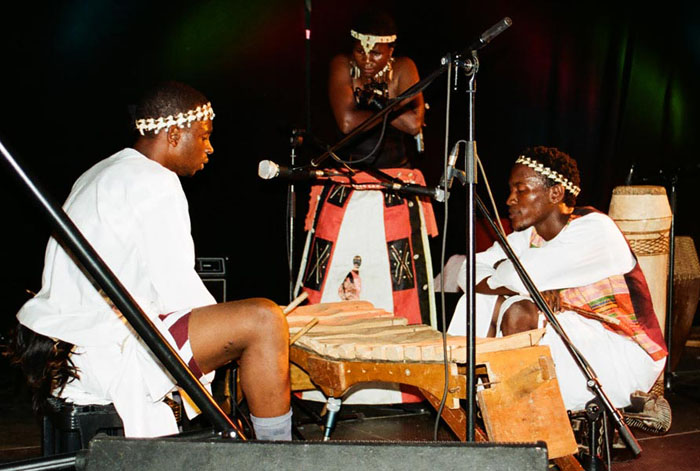
Lawrence Lubega - Sarah Ndagire - Israel Kalungi
The Hamites (Nilotic language)
The Nilotic-language speakers entered the area from the north, probably starting at about A D 100. They were the first cattle-herding people in the area, but they relied on crop cultivation to supplement livestock herding for subsistence. The Nilotes, as their name suggests, originally came from the Nile Valley, probably in southern Sudan. The first of these people are believed to have arrived around 500 BC, although Nilotic migrations only became substantial some five hundred years ago, with the arrival of the Luo and Masaai. Their main direction of movement was southwards along the plains of the Rift Valley, which favoured both their cattle-raising lifestyle, as well as their rapid, all-conquering advance into the country. By the seventeenth and eighteenth centuries, they had reached Tanzania, where their advance was finally stopped. Nilotes who have kept to their nomadic way of life are namely the Masaai and the Turkana.
The largest Nilotic population in present-day Uganda are the Iteso in the Karamoja region, a cluster of ethnic groups, speaking Eastern Nilotic languages. The Acholi, Langi and Alur speak Western Nilotic languages. Descendants of Eastern Nilotic peoples also live in Kenya, South Sudan, with the largest groups being settled in the Karamoja region in Uganda.
The Luo people
The Luo are part of the people from the southern Sudan. The migration brought changes during the 15th century with the Acholi people and with intermarriage. The Langi lost their Ateker language and migrated closer to the Lake Kyogo in the 18th century after living more than two hundred years in the Acholi region. They lost the system of pastoralism and began to speak Luo. Their origin were not the Luo but rather the Nilo-Hamites.
The Luo marked the last influence on the already settled population in the region in the West Nile and in northern and eastern Uganda. They introduced their language, culture and some animals and crops. The concept of the empaako name is of Luo origin, hence is the system of centralised states. They founded the Bunyoro-Kitara kingdom that was established after the collapse of the Bachwezi dynasty. Most of the West Nilotic languages in Uganda are called Lower Nilotic, and they are closely related to the language of the Luo in Kenya.
The Acholi people
The Acholi had a central government with a representative who was called Rwot (leader). He ruled and held court over life and death for his subjects. He was also the mediator between ancestors and the people.
Their being only scantily-clad is a rather characteristic tradition. Married men wear a small piece of goat-skin, which, though practically useless as a covering, is worn according to the tribal etiquette. Women prefer nudity or wear the tail, but dispense with the fringe in front. On their ears they wear ornamented small beads attached to pieces of brass. The Acholi practise no circumcision. Patterns with ornaments are tattooed on chest and stomach. For all men, even husbands, it is forbidden to touch the women‘s tails. Women are very respected for their independence and pugnacious nature, their honesty and their sexual morality. There are more women than men, and thus they are naturally inclined towards polygamy. Practically no woman lives unmarried her whole life. When she has lost her husband, she offers herself to a new one to get married. The act of naming a baby was of essential importance after birth. Names are not male or female, and a daughter often bears her father‘s name. The details or situation of the birth were therefore substantial.
They erected shrines (Avila) for the representative of the people, the so-called Jok. All rites as well as spiritual acts and worships were performed in the immediate surrounding of such shrines. They also worshipped this Jok as god and father of the people, who has come down from heaven and turned into a man. Additionally, they also worshipped the Dark Power, the devil, who was called Lubanga. Unfortunately, the Christians have used this name for the translation of God.
The legend says that the first man was called Luo; his father was the god Jok and his mother was Earth. In the family, there was a son with the name of Lagongo. He carried bells around his hips and ankles. His hair was decorated with feathers, he used to dance the whole day long. He had magical power. As his mother did not know who his father was, the story went that she had been made pregnant in the bush by Lubanga, the devil.
Neighbouring tribes to the southern are suspects, totemically. The religion appears to be a vague ancestor worship. In general, the Acholi have two other gods, called Awafwa and Ishishemi, the spirits of good and evil. To the former, cattle and goats are sacrificed. Similar to their neighbours, the Bantu, they have great faith in divination from the entrails of a sheep. Nearly everybody and everything is similar ominous of good or evil. They have few myths and traditions, with the ant-bear being the chief figure in their beastlegends. They believe in witchcraft and practise trial by ordeal. This is due to their fecundity and morality.
Those who live in the low-lying lands suffer from a mild malaria, while abroad they are subject to dysentery and pneumonia. Also epidemics of small-pox have occurred. Native medicine is the simplest. They dress wounds with butter and leaves, and in the case of an inflammation of the lungs or pleurisy, they pierce a hole into the chest. There are no medicine-men - the women are the witchdoctors. Both men and women work in the fields with large iron hoes. In addition to planting sorghum, eleusine and maize, tobacco and hemp are both cultivated and smoked. The Acholi were excellent hunters, with the prey enriching the daily menue. They lived on a mixed economy, land cultivation and livestock breeding. They hunted in different ways: either as a group or alone as trappers (Okia); they used nets, pits, or they hunted the animals into the water and subsequently killed them with their spears.
Acholi folk music is, like most Ugandan music, pentatonic. It is distinctive with choral singing, in parts with a lead voice. Songs are also accompanied by a string instrument, the harp-like adungu, and numerous percussion instruments. The vocal lines of the songs of men and women are in polyphonic style, and they tend to create a counter-point effect. Songs are performed at various occasions. The singing is melodic, and dances are performed collectively. Solo dancing is rather rare. The Acholi have various kinds of dances: Various dances are performed on certain occasions like, for example, birth, funeral, wedding, rituals (ancestral worship, beginning of a hunt, victory over enemies) and the celebration of the seasons (for example, thanksgiving).
1. Acherongo - Acholi people
- Sarah Ndagire: female voice
- Israel Kalungi: male voice, lead drum, small drum (Acholi drum), endege (ankle bells)
- Lawrence Lubega: male voice, engoma (Uganda drum), small drum (Acholi drum), endege (ankle bells)
This is a traditional song from the Acholi tribe. It is about a girl who is born with spiritual talents, these making her rather different to other girls. These girls are rather rare, and for this reason they are only married to great warriors or leaders who know how to lead or protect their tribe. If such girls are born, their birth is celebrated by the community with particular rites, and they are also raised rather carefully. It is believed that if these girls are married to great warriors, their children and descendants will also be given divine features.
In general, this song is also sung in accompaniment of the war dance (bwora dance). The men are morally obliged to perform with their spears and shields, and the women form a circle around them. The dance is rhythmically accompanied by the lead drum and the small Acholi drums in combination with the ankle bells made from metal.
4. Ajolina - Acholi people
Israel Kalungi: male voice, adungu (bow harp)
A song from the Acholi tribe in which a young boy praises a young and beautiful girl called Ajolina, whom he loves and wants to marry. He speaks about her as a gift given by nature, a divine beauty, and he praises her good character.
10. Ajooga - Acholi people
- Sarah Ndagire: female voice
- Israel Kalungi: male voice, adungu (bow harp), lead drum
- Lawrence Lubega: male voice, adungu (bow harp), adungu bass
Acholi worship and praise their god Jok.
They erected shrines (Avila) for the representative of the people, the so-called Jok. All rites as well as spiritual acts and worships were performed in the immediate surroundings of such shrines. They also worshipped this Jok as god and father of the people, who has come down from heaven and turned into a man. Additionally, they also worshipped the Dark Power, the devil, who was called Lubanga. Unfortunately, the Christians have used this name for the translation of God.
The legend says that the first man was called Luo; his father was the god Jok and his mother was Earth. In the family, there was a son with the name of Lagongo. He carried bells around his hips and ankles. His hair was decorated with feathers; he used to dance the whole day long. He had magical power. As his mother did not know who his father was, the story went that she had been made pregnant in the bush by Lubanga, the devil.
12. Abakono - Acholi people
- Sarah Ndagire: female voice
- Israel Kalungi: male voice, adungu (bow harp)
- Lawrence Lubega: male voice, adungu bass, engoma (Uganda drum), agwata (percussion gourd)
A gospel song from Acholi which urges people to come to God.
A praise song for their god and creator Jok. The melody remained, the texts, however, have been adapted to the Christianized values of today. Among friends, it is only naturally to still sing the original version of this song.
The Lugbara people
Their melodies are based on the court music, and it is quiter in nature and with complex rhythms. The tuning scale is more or less diatonic for most of these tribes. In other words, it is similar to the Congolesian (Zaire) music and furthermore, it tends towards the Western African music in general.
The Lugbara live in the highlands on an almost treeless plateau that forms the watershed between the Congo River and the River Nile. The Madi live in the lowlands to the east. The two groups both speak nearly identical languages and have strong cultural traditions. Both groups grow millet, cassava, sorghum, legumes, and a variety of root crops. Chicken, goats, and, at higher elevations, cattle are also important. Beer is brewed from corn, and the people also grow tobacco.
They were organised in clans, and their supremeleader was called Opi. He had to be a descendant of immigrants. He also often was the rainmaker. Land and livestock were appropriated to him. He decided on rituals and he decided when it was time to harvest. Jurisdiction was only valid when several clan leaders agreed upon the decision. It was further possible to pay off one‘s guilt.
The father was only the head of his own family, and everybody had to obey his decisions. On the occasion of a birth several rites were performed, starting with cutting the umbilical cord and ending with giving the baby a name. The initials of the tribe were tattooed onto the front face of girls as well as boys reaching the age of puberty. Also their front teeth were sharpened. It was not allowed to mourn before the funeral, as otherwise the soul could enter a lion or leopard and then attack the village community. Only after the funeral there took place a mourning ceremony with singing and dancing. Handiwork was produced working as a community, with baskets, ceramics and basic commodities being manufactured. Iron was melted, and the manufactured jewellery was especially well-liked and renown.
Mythology – All are descendants from the first creatures put on earth by spirit (the creator of men) at the beginning. Spirit created a man (gboro-gboro) and a woman (meme), and then domestic livestock.
Religion – They believe that the living and the dead will be of the same lineage and are in a permanent relationship with each other. As a result, the dead are aware of the actions of the living and care about them, whom they consider as their children. However, in some circumstances, the dead send sickness to the living in order to remind them that they are acting custodians of the Lugbara lineages and their shrines. God is also associated with that relationship between the living and the dead. He is the creator of men, who long ago created the world. However, he is conceived as god in the sky, remote and good (Onyiru), and as god in the streams, close to people, and dangerous "bad" (Onzi). While god created the world, the hero-ancestors and their descendants, the ancestors, formed their society.
Symbols – Shrines to the ancestors constitute one of the visible signs of Lugbara religion. There are many different kinds, the most prominent ones, however, being those erected for a ghost of an ancestor (Orijo, or ghost house). They are made of pieces of granite formed into a house and placed under the chief wife‘s granary. As a ghost spirit can create trouble for the living, he can have several shrines, where sacrificial food and beer can be offered by his descendants living in a particular compound. Other shrines include those built for the ancestors, shrines for those who did not leave sons behind, shrines for the ghosts of mother‘s brothers, and also for women of the lineage. Stones, as part of a shrine built to the ancestors, also constitute important symbols of wealth and prestige, and they are inherited by a person‘s sons after his death.
History - In their location in the Nile region, the Lugbara have been subject to only sporadic colonial administration since 1900, even though the area had been leased by the British to the Etat Independant du Congo since 1894. Some Arab expeditions entered in this region in the past; however, the Lugbara were not touched by the slave trade. The Belgians advanced through the area in 1900, opening a post at Ofude, to the west of Mount Eti, that lasted for several years. Followers of a prophet, Rembe, a Kakwa living about forty miles north of Lugbara, were subsequently entrusted by the colonial administration with overseeing the relationship between the Lugbara and the colonial authorities, creating powerful chiefs that had never existed before in Lugbara. In 1908, and after the death of the Belgian King, Leopold II, the area became part of the Sudan. By 1914 the southern portion of the Lado Enclave passed to Uganda, and a station was built at Arua. The Africa Inland Mission and the Roman Catholic Verona Fathers (Comboni Missionaries) arrived in the 1920s, they opened schools, and large missions staffed by Europeans.
6. Silimunyaigomu - Lugabara people
- Sarah Ndagire: ullulation
- Israel Kalungi: male voice, akadinda (xylophone)
- Lawrence Lubega: male voice, drum, akadinda (xylophone)
Illnesses and diseases (epidemics – like for example to day AIDS) came over a tribe. The people talk about their problems and sorrows arising therefrom.
7. Aferimoyamb - Alur people
- Israel Kalungi: adungu (bow harp), drum
- Lawrence Lubega: adungu (bow harp), adungu bass
A young man misses his girlfriend who went away a long time ago, and he describes his passion and his love for this girl. He hopes that she will come back soon, and that they will marry.
In such situations, the young people sing about the passion for love which will meet them one day, and then they will marry and become a part of the community.
The Baganda people
The Baganda people make up the largest ethnic group in Uganda, though they represent only 16.7 per cent of the population. (The name Uganda, the Swahili term for Buganda, was adopted by British officials in 1884 when they etablished, the Uganda Protectorate, centered in Buganda).
They speak a Bantu dialect called Luganda belonging to the Niger-Congo family. Like many other African languages, it is a tonal language which means that some words are differentiated by means of pitches. Words that are spelled in the same way, however, have a different meaning. It is a language that is rich in metaphors and proverbs.
Buganda is located in central Uganda and it is a region of the Baganda people. Its nucleus is Kampala city. Buganda‘s boundaries are marked by Lake Victoria in the south, the Victoria Nile River on the east, and Lake Kyoga on the north. The kingdom comprises 52 clans. At present it is the largest of the traditional kingdoms.
Their music is mainly slow with more emphasis on a regular meter. It is composed of contrasted lyrics and yodles (flactuating vocal lines). Since they are the origin of the Negro people, they have a huge variety of song forms such as; lullabies, historical songs, work songs, ceremonic songs, praise the kings (royal songs), wedding songs, etc. Their scale is purely pentatonic. Most of the vocal lines are in a responsarial form, solo form and chorus form. Since these songs are vocal dominant, they are basically meant to deal with social transformation. Funerals are major ceremonial and social events.
The Baganda passes through the stages of omwana (child), omuvubuka (youth), and omusajja or omukazi (man or woman). After death one becomes an omuzima (spirit), and the Baganda also believe in rebirth (reincarnation). After birth, the umbilical cord is retained for later use in a ceremony called Kwalula Abaana. During this ceremony the child gathers with other members of the father‘s clan to receive his/her name. Boys and girls are expected to conform in their behaviour to what the Baganda refer to as mpisa (manners). This includes being obedient to adults, greeting visitors properly, and sitting correctly (for girls). Sexual education for females is more systematic than it is for males. The father‘s sister (Ssenga) is the most significant moral authority for girls. Grandmothers instruct girls soon after their menstruation, during a period of seclusion, about sexual matters and future domestic responsibilities. Marriage and the birth of children are prerequisites for adult status. Women typically wear a busuuti. This is a floor-length, brightly coloured cloth dress with a square neckline and short, puffed sleeves. The garment is fastened with a sash placed just below the waist over the hips, and by two buttons on the left side of the neckline. Traditionally, the busuuti was strapless and made from bark-cloth. The busuuti is worn on all festive and ceremonial occasions. The indigenous dress of the Baganda men is a kanzu, a long, white cotton robe. On special occasions, it is worn over trousers with a Western-style suit jacket over it.
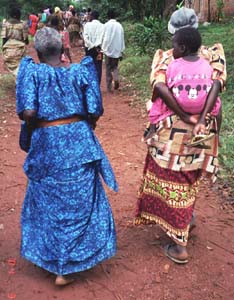 |
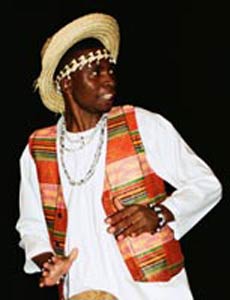 |
Busuuti –
children rests on the mothers back for mobility |
Kanzu –
with a Western-style suit jacket |
|
The bark from a species of fig trees called mutuba is soaked in water, then beaten with a wooden mallet. This yields a soft material that is decorated with paint and then cut into strips of various sizes. Larger strips traditionally were used for partitions in homes. Smaller pieces were decorated with black dye and worn as clothing by women. They have been replaced by the cotton cloth Busuuti. Bark-cloth is found today as decorative placemats, coasters, and design on cards of various sorts.
|
The staple food of the Baganda is matooke (a tropical fruit of the banana family – cooking banana). It is steamed or boiled and commonly served with groundnut (peanut) sauce or meat soup. Furthermore, they live on eggs, fish, beans, groundnuts, beef, chicken, and goats as well as termites and grasshoppers according to the season. Common vegetables are cabbage, beans, mushrooms, carrots, cassava, sweet potatoes, onions, and various types of greens. Fruits include sweet bananas, pineapples, passion fruit, and papaya. Drinks made from bananas (mwenge), pineapples (munanansi), and maize (musoli). Baganda have cutlery, but most prefer to eat with their hands, especially at home. Their homes are usually made of wattle and daub (woven rods and twigs plastered with clay and mud). Generally, they have thatched or corrugated iron roofs. More affluent farmers live in homes constructed of cement, with tile roofs. Cooking is commonly done in a separate cooking house over an open wood fire. The traditional term for marriage was jangu enfumbire (come, cook for me). After the wedding, a new household is established, usually in the village of the husband. The husband and father was supreme. Children and women knelt in front of the husband in deference to his authority, and he was served his food first. Basketry is still a widespread art. These mats are colourful and intricately designed. Most Baganda are peasant farmers who live in rural villages. Rich red clay on hillsides, a moderate temperature, and plentiful rainfall combine to provide a good environment for the year-round availability of plantain, the staple crop, as well as the seasonal production of coffee, cotton, and tea as cash crops.
Traditional Dances - Every tribe in Uganda has at least traditional dances. For example „Baakisiimba, Nankasa, Muwogola“ is a traditional dance that originated in the palace of the Buganda Kingdom. The Kabaka‘s Palace was a special place where royal dancers and drummers regularly performed. Dancing is frequently practised by all, beginning already in early childhood.
Riddles, myths and legends tell about the origin and history of the Baganda as well as the work of the real world. The most significant legend involves Kintu, the first Kabaka (king). He is believed to have married a woman called Nambi. Walumbe (Death) brings illness and death to children and then adults. Up to the present day, Death has lived upon the earth with no one knowing when or whom he will strike.
The Buganda believed in superhuman spirits. Balubaale were men who carried over into death. Mizimu were the ghosts of dead people. They believed that the soul still exists. The supreme power was the Creator, Katonda.
Some other Balubaale (about 37) had specific functions; there were the god of the sky, god of the rainbow, god of the lake, etc. They built for them all special shrines or temples. Temples were served by a medium or a priest who had powers over the temple. They also believed in spiritual forces, particularly the action of witches, who were thought to cause illness and other misfortune. People often wore amulets (charms) to ward off their evil powers. The most significant spirits were the Muzimu or ancestors who visited the living in their dreams and sometimes warned of impeding dangers. The Balubaale cult no longer exists. The belief in ancestors and the power of witches, however, is still quite common.
Each of the clans had a totem, which may not be eaten by a clan member, including: grasshoppers (nsenere), lungfish and one variety of beans. Ritual food: Food which was associated with feasts and celebration: Matooke (cooking banana), sesame, mushrooms, chicken and some fish have played an important role in the celebrations of the Kiganda. Presents and gifts in the form of dowry were typical for weddings, also the ceremony for naming a child, especially on the occasion of the birth of twins.
2. Wagwagwawala - Baganda people
- Lawrence Lubega: male voice, akadinda (xylophone)
This song is about people who simply do whatever they want to do, and who do not care whether their actions are good or bad for the community. This song is about such a person who only does what he wants to do and who does not care about the consequences and possible damage. At the end, however, this person regrets and says that everything has not been intended this way; the person apologizes.
3. Akanyomonyomo - Baganda people
- Sarah Ndagire: female voice, ullulation
- Israel Kalungi: male voice
- Lawrence Lubega: male voice, drums, ensaasi (shakers)
Please remember that ignoring other people is dangerous, this may result in bitterness, loss of friendships, etc.
5. Eyegema okuzaala - Baganda people
- Lawrence Lubega: male voice, endingidi (tube fiddle)
In this song there are cursed all girls who do not want to give birth and who want to decide this matter by using contraceptives.
In this song a man explains why he does not want to marry such a girl, as such women do only think of themselves and make the men their slaves. Women, however, are born to give birth and contribute in their way to the community. There are, unfortunately, also women who cannot give birth, these must not be blamed. But women, who are fertile and who are able to give birth and do not want to, should be avoided.
8. Maria mangada - Baganda people
- Israel Kalungi: male voice, endingidi (tube fiddle)
This is probably one of the oldest folk songs of the Buganda kingdom. It tells about a time long ago.
An old couple lives on memories in which the husband praises his diligent and hard-working wife who has accomplished more than simple everyday tasks and who has cared for him extremely well.
This song also tells about love and partnership in older times, and it compares the now and the then. It tells about love that people were aware of, about co-operation, and about the aim to have a good life together. Today it is only about wealth and prestige, which was not that important then.
9. Kooma okuswankula - Baganda people
- Lawrence Lubega: male voice, engoma (Uganda drum)
This song tells about healthy food which was well-cultivated in earlier times in the Ugandan kingdom. Parents ought to feed their children properly, and they should also teach them how to behave in a community.
This song tells about people who have an improper attitude towards food in the public. Because they have not been raised properly. Such attitudes have to be stopped immediately (such as chewing with your mouth open).
11. Mukyala kyusamu - Baganda people
- Lawrence Lubega: male voice, endongo (lyre)
A man tells about the increasingly bad manners his wife has adopted and that she has lost all respect for him as her husband. He laments that his wife is suddenly ignoring her good education and does not render him the respect she is due to owe him. A woman is supposed to maintain her manners and good education in dignity, also in respect to her husband, no matter where she has been born.
- more information about Uganda and people and her history you will find under: Uganda the country and the people
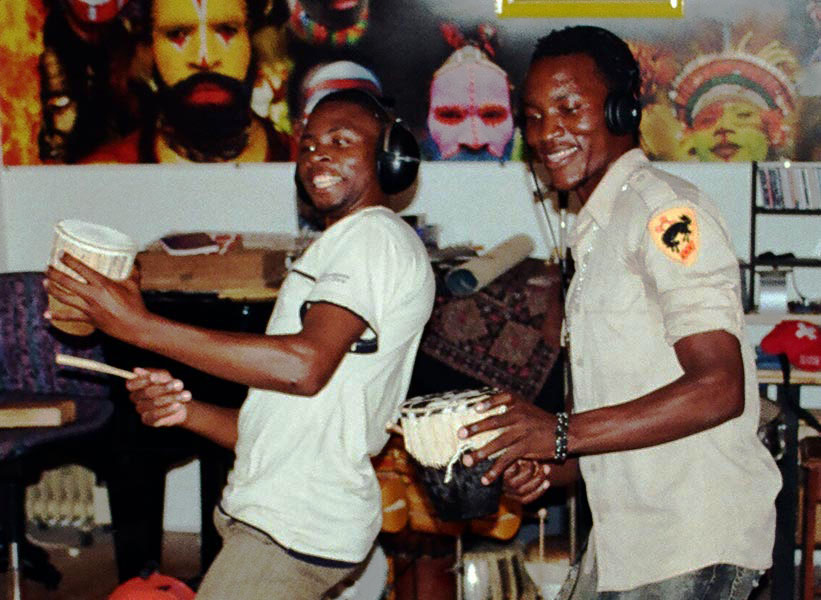
Lawrence Lubega – Israel Kalungi
Instruments
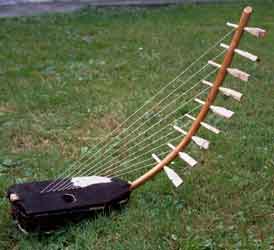 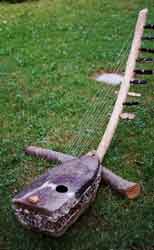
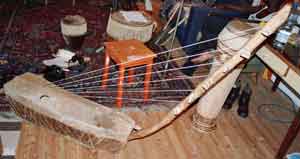
adungu bass
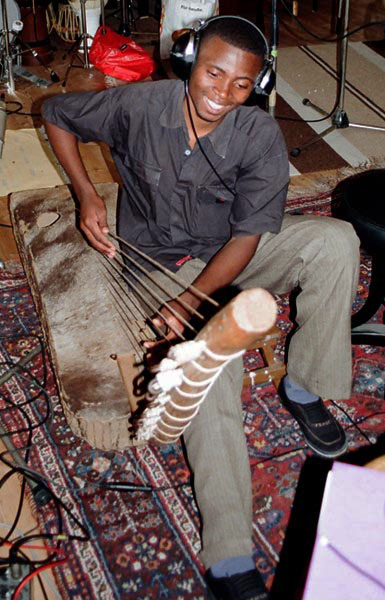
Lawrence Lubega
|
- Adungu, Adeudeu - bow harp - arched harp - string instument
The adungu is a nine-string arched (bow) harp of the Alur people of northwestern Uganda. It is very similar to the tumi harp of the neighbouring Kebu people, and it is also used by the Lugbara and Ondrosi tribes in this northwestern region around the Nile. The harp is used to accompany epic and lyrical songs, and it is also used as a solo instrument or within ensembles. Players of arched harps have had a high social status and are included in royal retinues. Nowadays they also play in churches.
The adungu consists of an arched neck, a wooden resonator (sound box) in which the neck is fixed, and a series of parallel strings of unequal lengths that are plucked. The strings are fixed at one end to the resonator and run at an oblique angle to the neck, where they are attached and tuned with pegs.
The first, second, and third strings are tuned in octaves with the sixth, seventh, and eighth respectively. In traditional music the instrument is tuned in a pentatonic (five-note) scale, but it can also be tuned in modern style to a diatonic scale.
|
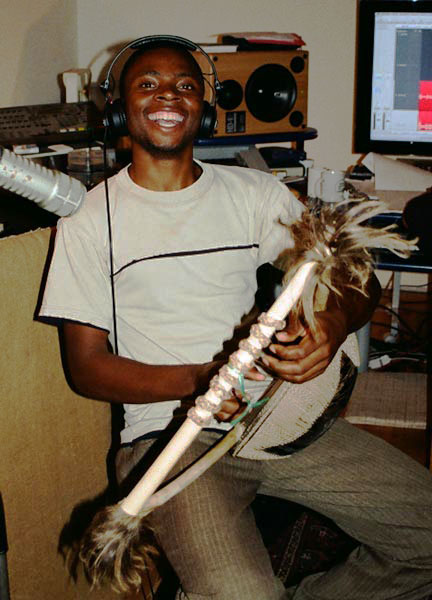
Lawrence Lubega¨
|
- Endongo - Entongoli
lyre - bowl lyre - harp lute - kora - string instrument
Baganda people sometimes called it endongo when they played to lead a wedding dance, (embaga). In eastern Uganda a similar instrument is called litungu. The Bagishu used it for the shoulder dance and called it kamabega.
This is the most representative instrument of the Baganda and Basoga. Generally, the harp-lute is the instrument of the griots, or praise-singers, much as the similar kora or soron is among the people of Guinea, Ivory Coast, Senegal, Gambia, and southern Mali. It is played either solo or to accompany songs of praise. The endongo has six to eight strings which are plucked. However, the instrument's structure differs significantly from the harp proper. It is made with a large hemispherical sound-box made from a gourd, crossed by a long and straight cylindrical neck or crossbar, the lower end of which extends beyond the base and serves to hold the strings. The strings are made of ox tendons attached to plated leather rings that can be slid up and down the crossbar to tune the strings. The strings run along the two sides of a large notched bridge in the center of the sound table, dividing them into two parallel sets. The player holds the instrument in front of him, so that he may pluck the strings between the bridge and the neck with the thumbs and forefingers of each hand. The lyre has a four-sided frame consisting of the sound box, two arms, and a crossbar.
The endongo, the lyre of the Ganda (Baganda), has one hole, and the entongoli, the lyre of the Songa, has two pieces of cloth, bark, or banana leaves wrapped around the frame. The strings are wound tightly around the fiber which then serves as a tuning peg. The strings are not in order of their pitches. The highest note in the scale is the third from the left and the lowest is the fifth string. Strings 7, 2, 4, 1, and 5 are tuned in octaves.
|
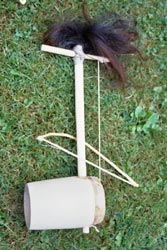
|
- Endingidi - Adigirgi - tube fiddle - one-string-fiddle - string instrument
This instrument is popular in the Buganda, Busoga, Ankole, Kigezi, western Nile, and Acholi regions. It consists of a single string, which is attached to a flexible stick and will sometimes have a resonator. Unlike other single-string instruments, it is played with a bow.
|
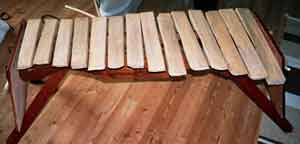
|
- Akadinda - Embaire - Entaara - Amadinda - xylophone
The xylophone is a very popular instrument in the Bantu region. The amadinda and akadinda vary in size and number of keys, though both are tuned in an equidistant pentatonic scale. The keys are separated by either long sticks (among the Buganda) or short ones and are placed on banana stems. The Bakonyo and Basoga use both short and long sticks. The keys are tied in place by threading a string through small holes in the wood.
|
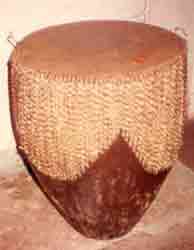
|
- Namunjoloba - Akaduumi – lead drum - percussion instrument
Drums in African tradition bring the power that drives a performance. Music is not merely entertainment, but is ultimately bound to visual and dramatic arts as well as the larger fabric of life. Drums may be used for "talking," that is, sending information and signals by imitating speech. Many African languages are both tonal (that is, meaning can depend on pitch inflections) and rhythmic (that is, accents may be durational), giving speech a musical quality that may be imitated by drums and other instruments. Drumming music and dance are almost always an accompaniment for any manner of ceremony; birth, marriages, funerals.
|
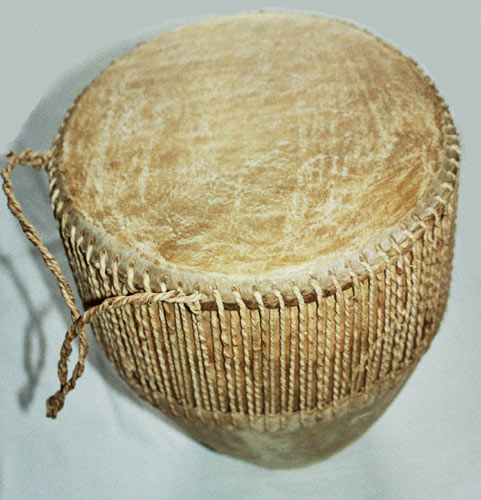
|
- Engoma - Empuunyi - Uganda drum - percussion instrument
Embuutu; big drum, Empuunyi; bass drum.
While larger versions of this drum are traditionally hand-carved from old-growth hardwood trees, now these drums are made with pinewood slats tied together like barrels. Smaller drums are laminated and turned on a lathe and may be provided with a rope carrying the handle. All these drums have heads made from hide held by hardwood pegs hammered into the side of the drum.
|
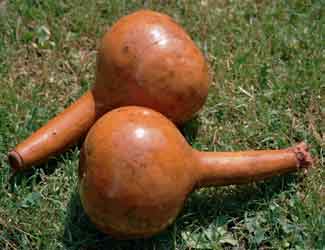
|
- Ensaasi - Akacence - Enseege - shakers - percussion instrument
Shakers are made in pairs from gourds or shells, sometimes with stick handles, and are used to accompany other traditional instruments in Uganda. The central and northern (Alpaa) regions have shakers that produce a continuous sound as beads move from side to side in the gourd or shell. Generally, these shakers produce sounds by many small objects, such as pebbles, rattling together inside the body.
|
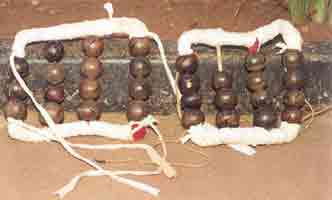 |
- Endege – ankle bells - percussion instrument
Dancers frequently have metal jingles tied on their ankles to articulate their movements.
|
Revised by Hermelinde Steiner
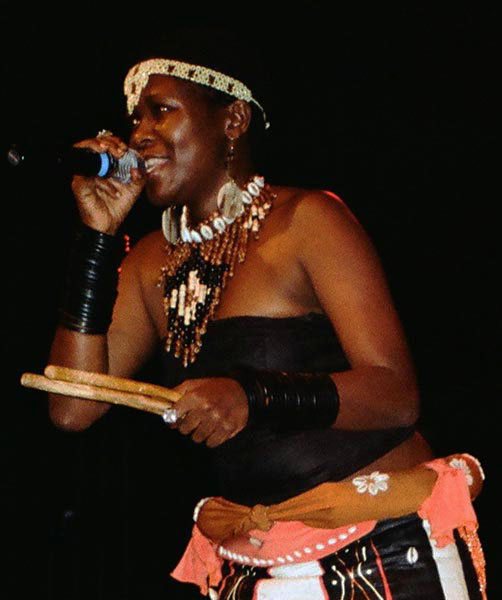
PageTop

|
